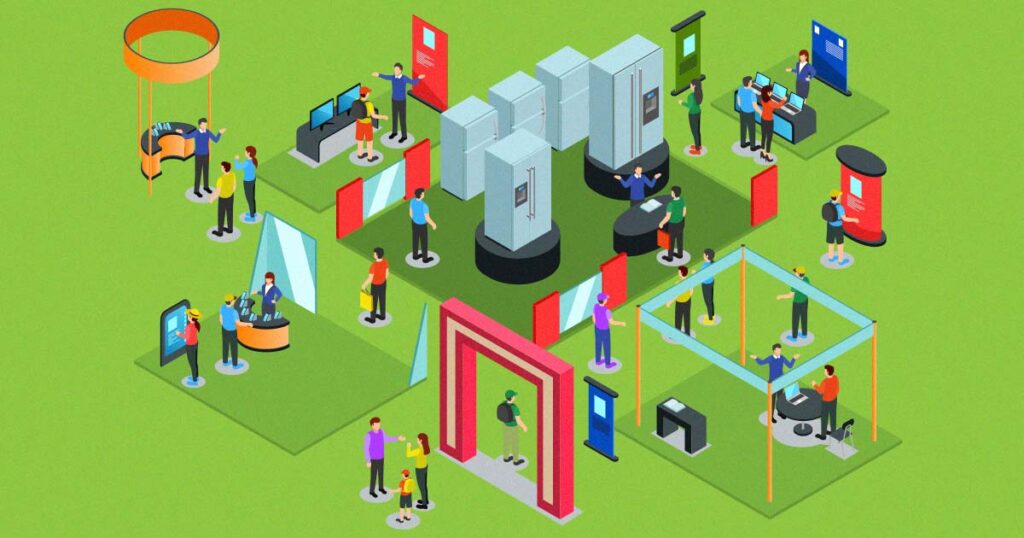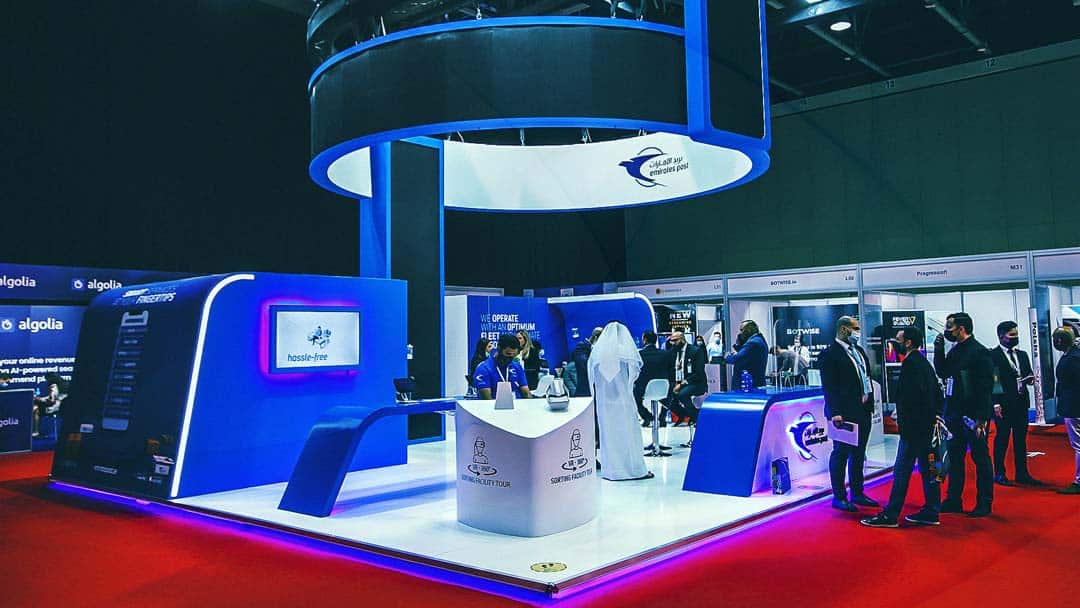Trade shows are a cornerstone for B2B businesses, offering a prime opportunity to showcase products and connect directly with potential clients. Embracing trade show booth design best practices is beneficial and essential for making a significant impact. A great way to captivate and engage attendees is through meticulous exhibit design.

By integrating innovative and strategic elements into your booth, you can dramatically increase the effectiveness of your trade show presence. Understanding and applying these design best practices can be the key to turning a routine exhibit into a remarkable success.
Key trade show booth design best practices include:
- Aligning design with target audience and goals
- Focusing on branding and visual impact
- Incorporating interactive elements and technology
- Engaging with trade show visitors through personalized experiences
By implementing these strategies, B2B companies can maximize their ROI and achieve their trade show objectives, such as generating leads, increasing brand awareness, and showcasing products or services.
Understanding Your Audience and Goals

Pre-Design Considerations
Before diving into the design process, it’s essential to lay the groundwork for success by addressing key pre-design considerations. These considerations will guide your design choices and ensure your booth aligns with your objectives and target audience.
Defining Your Target Audience
Understanding your target audience is crucial for creating a booth that resonates with attendees. Consider factors such as:
- Job titles and roles
- Industry and sector
- Pain points and challenges
- Interests and preferences
By developing a clear picture of your ideal visitor, you can tailor your design, messaging, and engagement strategies to their needs and preferences.
Setting Clear Goals
Establish specific, measurable goals for your trade show participation. Common objectives include:
| Goal | Description |
| Lead Generation | Collecting contact information from potential customers |
| Brand Awareness | Increasing visibility and recognition of your brand |
| Product Demos | Showcasing your products or services to attendees |
Align your goals with your overall marketing and business objectives to ensure a cohesive strategy.
Aligning Booth Design with Audience and Goals
Your booth design should be a reflection of your target audience and goals. Consider how your design choices can support your objectives:
- Lead Generation: Include clear calls-to-action and lead capture mechanisms
- Brand Awareness: Showcase your brand’s unique personality and values
- Product Demos: Incorporate interactive displays and demonstration areas
By aligning your design with your audience and goals, you can create a booth that effectively communicates your message and engages visitors.

Determining Budget and Booth Size
Your budget and booth size will significantly impact your design options. Consider factors such as:
- Available trade show space and layout
- Booth rental or purchase costs
- Design, fabrication, and installation expenses
- Shipping and storage fees
Work with your team to determine a realistic budget and select a booth size that allows for effective design while staying within financial constraints.
By addressing these pre-design considerations, you’ll lay the foundation for a successful trade show booth design that attracts visitors, communicates your message, and achieves your goals.
Essential Design Elements

With your pre-design considerations in place, it’s time to focus on the essential elements that will bring your trade show booth to life. These design elements work together to create a cohesive, engaging, and memorable experience for your visitors.
Branding
Consistent branding is essential for creating a recognizable and memorable presence at trade shows. Ensure that your booth design incorporates your brand’s visual elements, such as:
- Company Logo
- Color palette
- Typography
- Imagery and graphics
In addition to visual consistency, your booth should communicate your brand’s unique story and values. Use messaging and design elements that showcase your brand identity and differentiate you from competitors.
Layout and Flow
The layout and flow of your booth can significantly impact visitor engagement and the overall effectiveness of your design. Consider the following when planning your booth layout:
| Booth Size | Recommended Layout |
| 10×10 | Inline or corner |
| 10×20 | Peninsula or island |
| 20×20+ | Island |
How to design trade show booth graphics?
Graphics and signage are crucial in attracting visitors and communicating your message. When designing your graphics and signage, keep the following best practices in mind:
Studies show that attendees spend an average of 3-5 seconds scanning a trade show booth. Ensure your graphics and signage effectively communicate your key message within this brief timeframe.
Product Displays and Demonstrations
Showcasing your products or services is a primary goal for many trade show exhibitors. To effectively highlight your offerings, consider the following:
- Create visually appealing displays that showcase your product’s features and benefits
- Incorporate interactive elements, such as touch screens or virtual reality experiences, to engage visitors
- Provide opportunities for hands-on demonstrations and product trials
- Use lighting and other design elements to draw attention to your displays
Lighting and Ambiance
Lighting and ambiance can significantly impact your trade show booth’s overall look and feel. Use lighting strategically to:
- Highlight key areas, such as product displays or branding elements
- Create a warm and inviting atmosphere
- Enhance the visual impact of your graphics and signage
In addition to lighting, consider other ambiance-enhancing elements, such as:
- Flooring and carpeting
- Color schemes
- Furniture and décor
Technology Integration
Integrating technology into your booth design can help you engage visitors, capture leads, and create memorable experiences. Consider incorporating elements such as:
- Interactive touch screens or kiosks
- Virtual or augmented reality experiences
- Digital lead capture systems
- Social media walls or hashtag displays
By carefully planning and executing these essential design elements, you can create a trade show booth display that effectively showcases your brand, engages visitors, and achieves your goals.
Measuring and Optimizing Success

You’ve worked hard to design an amazing trade show booth and engage your audience, but how do you know if your efforts were truly successful? In this section, we’ll discuss the essential metrics to track, the importance of data analysis, and how to continuously improve your trade show performance.
Defining Key Performance Metrics
To measure the success of your trade show booth, you need to establish clear, quantifiable metrics that align with your goals. Some key performance indicators (KPIs) to consider include:
Data Tracking and Analysis
To effectively measure your KPIs, you need a system for tracking and analyzing data. Consider the following tools and strategies:
- Lead capture software: Use digital lead capture tools, such as badge scanners or mobile apps, to streamline the process of collecting and organizing lead information.
- Surveys and feedback forms: Create brief surveys or feedback forms to gather insights from visitors about their experience with your booth and brand.
- Analytics platforms: Utilize tools to track visitor behavior, such as booth traffic patterns, dwell times, and engagement with interactive elements.
Continuous Improvement for Future Trade Shows
Measuring your success is just the first step – the real value lies in continuously using those insights to improve your trade show performance. After each event, take the time to:
Analyze your data
Review your KPIs and identify areas of strength and weakness. Look for patterns and trends that can inform future strategies.
Gather team feedback
Conduct a post-show debrief with your team to discuss what worked well, what could be improved, and any key learnings from the event.
Refine your approach
Based on your data analysis and team feedback, make data-driven decisions to optimize your booth design, audience engagement strategies, and overall trade show approach for future events.
Test and iterate
Don’t be afraid to experiment with new design ideas and tactics. Continuously test and refine your approach to find what works best for your brand and audience.
By defining clear metrics, tracking and analyzing data, and continuously refining your approach, you can ensure that your trade show investments drive meaningful results for your business. Remember, success is an ongoing process – by staying agile and adaptable, you can optimize your trade show performance and achieve your goals year after year.
Common Mistakes to Avoid

Even with the best intentions and a well-designed booth, it’s easy to fall prey to common trade show pitfalls. To ensure your success, be mindful of these potential missteps and take proactive steps to avoid them.
Cluttered or Confusing Messaging
When it comes to trade show booth design, less is often more. Avoid overwhelming visitors with too much text, imagery, or competing messages. Instead, focus on crafting clear, concise messaging that communicates your key value propositions and differentiators.
Remember, attendees often scan booths quickly, so ensure your messaging is easy to digest at a glance. Use bullet points, short phrases, and bold visuals to convey your most important information.
Poor Lighting and Visibility
Don’t underestimate the power of lighting in your booth design. Poor lighting can make your booth appear dull, uninviting, or invisible among competitors. Ensure your booth is well-lit, with strategic spotlights highlighting key areas such as product displays or branding elements.
In addition to lighting, consider your booth’s overall visibility. Make sure your signage is positioned at eye level and can be easily read from a distance. Use contrasting colors and bold fonts to make your booth stand out on the trade show floor.
Lack of Brand Consistency
Inconsistent branding can confuse visitors and dilute your brand’s impact. Ensure that all booth design elements – from graphics and signage to staff attire and promotional items – align with your brand guidelines.
Failing to Engage Visitors
Don’t make the mistake of treating your booth as a static display. Actively engage visitors through interactive demonstrations, personalized conversations, and memorable experiences.
Train your booth staff to be proactive in initiating conversations and guiding visitors through your booth. Encourage them to ask open-ended questions, listen attentively, and tailor their responses to each visitor’s unique needs and interests.
Visitor Engagement Tips:
- Greet visitors with a smile
- Ask open-ended questions
- Listen actively
- Personalize your approach
- Offer interactive experiences
Avoid these common mistakes and focus on creating a clear, consistent, and engaging trade show experience! You’ll be well-positioned to achieve your goals and make a lasting impression on your target audience.
In today’s competitive B2B landscape, a well-designed trade show booth is a powerful tool for engaging your target audience, generating leads, and driving business growth. By implementing the best practices outlined in this guide, you can create a booth that effectively showcases your brand, communicates your value proposition, and leaves a lasting impression on attendees.
A successful trade show strategy extends beyond just the design of your booth. It also encompasses pre-show planning, audience engagement, and post-show analysis and optimization. By taking a holistic approach and continuously refining your tactics, you can maximize your trade show ROI and achieve your business goals.
Looking to enhance your next trade show display?
Dive into the world of expert booth design ideas with Blue Atlas Marketing, your dedicated partner in trade show marketing services. Our specialized strategies are crafted to seamlessly integrate into your marketing plan, ensuring your booth stands out and captivates your audience at your next trade show.
Whether refreshing your design or creating a new concept, our insights and innovations are tailored to your needs. Elevate your trade show experience with us. Contact us to discover how Blue Atlas Marketing can transform your trade show presence!







